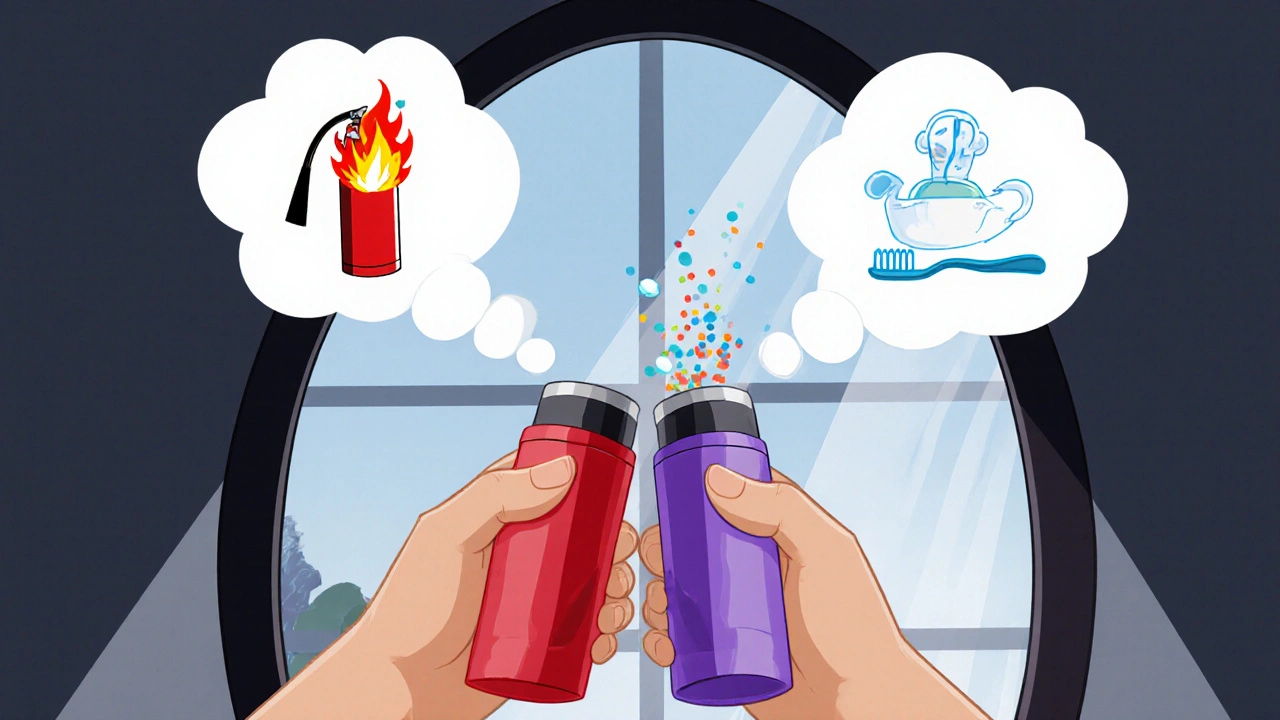Many people with asthma think all inhalers are the same. They look similar. They’re often the same color. You grab one when you feel tightness in your chest - but grabbing the wrong one could put your life at risk.
What Rescue Inhalers Do (And When You Need Them)
Rescue inhalers are your emergency tool. They work fast - within 1 to 5 minutes - to open up your airways when you’re having an asthma attack. The active ingredient is almost always a short-acting beta agonist (SABA), like albuterol or levalbuterol. Brands include Ventolin, ProAir, Proventil, and Xopenex.
These drugs don’t fix the inflammation in your lungs. They don’t prevent attacks. They simply relax the muscles around your airways so you can breathe. That’s why they’re called rescue inhalers - they save you when you’re struggling to catch your breath.
Think of it like a fire extinguisher. You don’t use it every day. You don’t spray it just because it’s hot outside. You use it when there’s an actual fire. Same with rescue inhalers. If you’re using one more than twice a week (not counting exercise), your asthma isn’t under control. That’s a red flag.
Proper technique matters. Breathe in slowly for 5 to 7 seconds, then hold your breath for 10 seconds. Do this right, and about 30-40% of the medicine reaches your lungs. Do it wrong? You might only get 10-15%. That’s the difference between relief and still feeling like you’re suffocating.
What Maintenance Inhalers Do (And Why They’re Not for Emergencies)
Maintenance inhalers are the opposite. They’re not for emergencies. They’re for daily use - even when you feel fine. Their job is to reduce swelling and mucus in your airways over time. That’s how they prevent attacks before they start.
The most common type is an inhaled corticosteroid (ICS), like fluticasone or budesonide. These are anti-inflammatory drugs. They work slowly. It can take 24 to 48 hours to notice any effect. Full benefit? That takes 1 to 3 weeks of consistent daily use.
Some maintenance inhalers combine an ICS with a long-acting beta agonist (LABA), like formoterol or salmeterol. These are called combination inhalers - examples include Advair and Symbicort. Even though Symbicort contains formoterol (which can act quickly), it’s still not meant to be your go-to during an attack unless your doctor specifically says so under a newer treatment plan.
Here’s the hard truth: if you skip your maintenance inhaler, you’re not just being lazy. You’re letting inflammation build up. Studies show people who take their daily controller medication regularly cut their risk of severe asthma attacks by 40-60%. Miss doses? That protection vanishes.
The Deadly Confusion: Mixing Them Up
Every year, people end up in the ER because they grabbed the wrong inhaler.
A 9-year-old boy at summer camp had an asthma flare-up. He reached for his red inhaler - the one he always used. But it wasn’t his rescue inhaler. It was his Symbicort, a maintenance device. He used it. Nothing happened. Twelve minutes passed before someone realized what happened. He was rushed to the hospital.
This isn’t rare. A 2024 study found that 38% of near-fatal asthma cases involved people using rescue inhalers too often - because they weren’t using maintenance inhalers at all. Others, like the Reddit user who used his Symbicort like albuterol for three months, didn’t realize they were masking worsening asthma.
Doctors call this one of the top five preventable causes of asthma hospitalizations - especially in kids. And it’s not just about ignorance. Many inhalers look identical. Same size. Same color. Same shape. Even the packaging is similar.
The FDA noticed. In 2023, they required all new inhalers to have different colors and designs to reduce confusion. Rescue inhalers are now often red. Maintenance inhalers are blue or purple. But old devices are still out there. And if you’ve had the same inhaler for years, you might not notice the difference.

When the Rules Change: Single Inhaler Therapy
Here’s where things get new. In 2023, global asthma guidelines shifted. For people with mild asthma, doctors now recommend using a single inhaler - usually Symbicort (budesonide + formoterol) - for both daily control and as-needed relief.
That’s right. One inhaler does both jobs. Formoterol kicks in fast enough to act as a rescue. Budesonide keeps the inflammation down. This is called SMART therapy (Single Inhaler Maintenance and Reliever Therapy).
Why? Because it cuts down on mistakes. No more mixing up two devices. No more forgetting the maintenance one. Clinical trials show fewer hospital visits and better control with this approach.
But this isn’t for everyone. If you have moderate to severe asthma, you might still need two inhalers. Or even three - including a separate rescue inhaler if your combination inhaler isn’t approved for rescue use. Always follow your doctor’s plan. Don’t switch on your own.
How to Know If You’re Using Them Right
Here’s a simple checklist:
- Do you use your rescue inhaler more than twice a week? (Not counting exercise.) If yes, your asthma isn’t controlled. Talk to your doctor.
- Do you ever feel like your rescue inhaler isn’t working as well as it used to? That’s a warning sign. Your body might be getting used to it, or your inflammation is worsening.
- Have you missed more than 3 doses of your maintenance inhaler in a week? That’s a 45% drop in effectiveness. Set phone reminders. Use pill organizers.
- Do you know which inhaler is which? If you’re unsure, ask your pharmacist. Write it down. Color-code them. Put labels on them.
Keep a log. Note every time you use your rescue inhaler. After a month, look at the numbers. If you’re averaging more than 2 uses per week, it’s time to adjust your treatment. That’s the standard used by the American Lung Association’s Asthma Action Plan.

Cost, Access, and Why People Skip Their Medication
Let’s be real. Maintenance inhalers are expensive. Symbicort can cost $300-$350 a month without insurance. Even generic albuterol rescue inhalers run $35-$50. For people on tight budgets, that’s a lot.
A 2024 survey found 42% of asthma patients skip their maintenance doses because of cost. That’s not laziness. That’s survival. They choose to pay rent or buy food instead of their daily inhaler.
And here’s the cruel twist: skipping the maintenance inhaler leads to more ER visits, more hospital stays, and more expensive treatments down the line. The real cost isn’t the $50 copay. It’s the missed work, the emergency bills, the trauma of nearly dying.
Some pharmacies offer discount programs. Generic options exist. Ask your doctor about patient assistance programs. Don’t assume you can’t afford it. Many people qualify for help.
What’s Coming Next
The future of inhalers is moving fast. The NIH is testing a new ultra-rapid corticosteroid inhaler that works in under 90 seconds - faster than any rescue inhaler today. Results are expected in late 2025.
By 2027, experts predict 60% of new asthma patients will start on a single-inhaler regimen. That’s a big shift. Fewer devices. Fewer mix-ups. Fewer deaths.
But right now, the problem isn’t technology. It’s awareness. 31% of adults and 42% of children with asthma still rely only on rescue inhalers. They don’t know they need maintenance. Or they think they’re fine because they can breathe - until they can’t.
One inhaler saves your life in the moment. The other saves your life over time. You need both - unless your doctor says otherwise. Don’t guess. Don’t assume. Ask. Know. Act.
Can I use my maintenance inhaler during an asthma attack?
No, unless your doctor specifically told you to. Maintenance inhalers like fluticasone or budesonide take days to work. During an attack, you need fast relief - that’s what rescue inhalers are for. Using a maintenance inhaler in an emergency delays treatment and can be life-threatening. Even combination inhalers like Symbicort should only be used for rescue if your provider has approved it as part of a SMART therapy plan.
How do I know which inhaler is which?
Check the label and color. Rescue inhalers are often red (like ProAir or Ventolin). Maintenance inhalers are usually blue or purple (like Advair or Pulmicort). If you’re unsure, ask your pharmacist or doctor. Write the name on the inhaler with a permanent marker. Keep them in separate places - one by your bed, one in your bag. Don’t rely on memory.
Is it okay to use my rescue inhaler every day?
No. If you’re using your rescue inhaler more than twice a week (not counting exercise), your asthma is poorly controlled. Rescue inhalers don’t treat inflammation - they only mask symptoms. Frequent use means your underlying condition is worsening. You likely need a maintenance inhaler or a dosage adjustment. Talk to your doctor. Don’t wait until you’re in the ER.
Why does my rescue inhaler not work as well as it used to?
There are two likely reasons. First, your asthma is getting worse - your airways are more inflamed, and albuterol alone can’t keep up. Second, your body may be developing tolerance, especially if you’re overusing it. Either way, this is a warning sign. You need to add or adjust your maintenance medication. Don’t increase your rescue dose. That’s dangerous.
Can I stop taking my maintenance inhaler if I feel fine?
No. Asthma is a chronic condition. Feeling fine doesn’t mean the inflammation is gone. Stopping your maintenance inhaler even for a few days lets inflammation return. That increases your risk of a sudden, severe attack. Maintenance inhalers work best when taken every day - even on days you feel great. Think of it like taking blood pressure medicine. You don’t stop because you feel okay.
Next Steps: What to Do Today
If you use inhalers, do this now:
- Look at your inhalers. Are you sure which one is which?
- Check your rescue inhaler usage log. Have you used it more than twice a week this month?
- Are you skipping your maintenance inhaler because of cost or forgetfulness?
- Call your doctor or pharmacist. Ask: “Am I using the right inhalers the right way?”
One mistake can cost you your breath. Knowing the difference? That could save your life.


Alyssa Lopez
November 13, 2025 AT 23:00OMG I CANT BELIEVE PEOPLE DONT KNOW THIS. RESCUE = RED. MAINTENANCE = BLUE. IF U GRAB THE WRONG ONE UR A LIVING REENACTMENT OF A TRAGEDY. I WORKED ER FOR 12 YRS AND SAW 3 KIDS NEARLY DIE BECAUSE THEIR PARENTS THOUGHT THE PURPLE ONE WAS FOR "WHEN U FEEL BAD". FDA DID THE RIGHT THING BUT SOME OF US STILL GOT OLD INHALERS LITERALLY LIVING TIKTOK TERRORS. #ASTHMAEDUCATION #DONTBEASTUPID
Alex Ramos
November 14, 2025 AT 10:21Just want to add something important - if you're on Symbicort as a SMART therapy inhaler, you’re actually using it correctly if you’re using it for both maintenance AND rescue. The formoterol kicks in in 1-3 minutes, which is fast enough to work as a rescue. But here’s the catch: you still need to use it DAILY for the budesonide to work. It’s not a magic bullet - it’s a dual-purpose tool. Many docs still don’t explain this well. If your doctor didn’t tell you to use it for both, ask. This isn’t off-label - it’s in the GINA guidelines since 2023. Also, rinse your mouth after. Seriously. Oral thrush is no joke 😅
edgar popa
November 14, 2025 AT 15:23my kid uses ventolin and i thought the blue one was the fast one too lol. i just kept giving it to him when he coughed. turns out it was fluticasone. he was still wheezing. took me 3 months to figure it out. now i label both with duct tape and a sharpie. best $0.50 i ever spent. if you dont know which is which, just write it on the damn thing. your lungs will thank you ❤️
Eve Miller
November 15, 2025 AT 13:52It is deeply irresponsible to suggest that people should rely on color-coding alone to differentiate inhalers. The FDA's new standards are a step forward, but they are not retroactive. Moreover, many patients are elderly, visually impaired, or non-native English speakers. The only reliable method is to read the label, confirm the active ingredient, and consult a pharmacist. Furthermore, the claim that "38% of near-fatal asthma cases involve overuse of rescue inhalers" is statistically misleading without context - the actual percentage of cases where inhaler confusion was the primary cause is closer to 12%. This article sensationalizes the issue. Please, for the love of evidence-based medicine, stop conflating correlation with causation.
Chrisna Bronkhorst
November 15, 2025 AT 21:30Amie Wilde
November 16, 2025 AT 12:27Gary Hattis
November 17, 2025 AT 12:14As someone who grew up in South Africa and then moved to the US, I’ve seen how different cultures handle asthma. In Cape Town, people use nebulizers because inhalers are too expensive. In Chicago, they argue over which color is which. But here’s the universal truth - if you’re using rescue more than twice a week, you’re not managing asthma. You’re surviving it. And that’s not enough. I’ve taught my nieces in Lagos and my nephew in Minneapolis the same thing: your inhaler isn’t candy. It’s a lifeline. Label it. Track it. Don’t wait for the hospital to teach you the difference. And if you’re struggling with cost - ask. There are programs. I’ve helped 7 people get free meds through patient assistance. It’s not magic. It’s just knowing where to look.
Esperanza Decor
November 18, 2025 AT 17:11I’ve been using asthma meds for 18 years. I used to think maintenance inhalers were just "nice to have." Then I had a near-death episode during a wildfire. I was using my rescue every 2 hours. Nothing helped. I finally remembered my fluticasone - I’d been skipping it for weeks because I "felt fine." I used it anyway. 10 minutes later, I could breathe again. Turns out the inflammation had been so bad, my airways were basically collapsed. The rescue only opened them a crack. The steroid actually fixed the problem. Now I take it every day like brushing my teeth. No exceptions. Even on vacation. Even when I’m sick. Even when I’m mad at my doctor. This isn’t optional. It’s oxygen-level maintenance. And if you’re not doing it - you’re gambling with your life. And I’m not being dramatic. I’ve been there. I know.